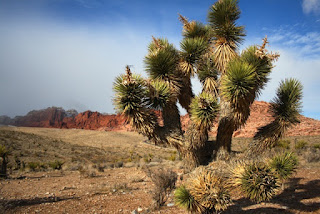Monster, achievable rock-climb
Bunny Bucket Buttress, 270m, Grade 18 sport climbPierces Pass, Blue Mountains
 |
| Ken Eastwood, nearing the top of pitch 7 |
For those who love vertical
adventures, here’s one of the best days out you can have within a hop, skip and
abseil of Sydney: a 270m towering mid-grade climb that is pre-bolted. That’s
right. Most long routes in the Blue Mountains, and in fact elsewhere, are trad
routes (meaning there are no bolts, and so you need a full rack of gear, and
frankly I still haven’t scraped together the $1200 minimum for a proper rack)
or are heart-stopping, finger-crimping extreme routes suited only to hardened (generally
young) climbers who do nothing else but climb ridiculously hard routes.
This beautiful eight-pitch
adventure, given the maximum five stars in the excellent Blue Mountains Climbing guide, 2010,
was established in 2005. Originally a rich harvest of old “carrot” bolts, it is
now fully ringbolted, with each bolt a comfortable 2–5m from the last. There
are no hanging belays – all reasonable ledges, and the sixth and seventh
pitches are up a gorgeous vertical headwall with plenty of “bucket” holds.
Earlier this year I had the
absolute pleasure of experiencing this route – for hopefully the first of many
times – with 21-year-old Blue Mountains Adventure Company guide Eric Butler.
 |
| Eric Butler |
Eric, who often chooses to climb and walk barefoot in the
tradition of his grandmother Dot, aka “the barefoot bushwalker”, was on a day
off, but had always wanted to do the route. I’d met Eric while climbing and
doing a story on Warrumbungle National Park for Australian Geographic (http://www.australiangeographic.com.au/journal/warrumbungle-national-park-victoria-.htm).
An excellent climbing partner
and great bloke, Eric is always calm, in control and happy to trade leads. We
met at the top Pierces Pass carpark off Bells Line of Road, walked down to a
few hundred metres before Walls Lookdown Lookout, then veered left on the thin
track. This track takes you to the legendary “lunch ledge”, a precipitous eyrie
with a multitude of climbs going above and below.
 |
| Eric sets up the first abseil |
I was freaking out a little at the top of the abseil.I’ve never really loved abseiling – that thing of completely trusting the rope, rather than just having the rope there if you fall. Plus, I knew full well that the climb next to Bunny Bucket Buttress had seen the death of a climber in 2009 when incorrectly placed bolts pulled out of the rock. And there were fires elsewhere in the Blue Mountains, and I knew once we committed, we had a long way out. Eric’s light and seemingly spider-web-like 8.5mm ropes (rather than my 10.5mm ones) also meant that I rocketed down the rope faster than I expected.
 |
| Pierces Pass, showing the vegetated lunch ledge |
From the bottom, it’s just
a couple of hundred metres walk along the base of the cliff to the start of the
climb, which is marked BBB.
Bunny Bucket has a few
great surprises, and I won’t spoil them all, but the starting move is almost
the hardest move of the climb. It’s a weird, foot-free, bouldery move and a
mistake could be quite serious, as it’s over a small drop. But it is achievable
in a variety of ways.
The first two pitches are
fairly short and similar, the third slightly harder with holds a little more
difficult to find. Pitch four is easy and fun, and pitch five more like a
bushwalk (Eric had no shoes by this point).
Pitch 6 was my hardest
lead, with an odd, almost foot-free traverse under an overhang, then
disappearing around the overhang up onto the headwall. For me it was an awesome
but achievable challenge, and Eric had the grace to at least pretend he
struggled with a couple of moves.
The seventh pitch has those
beautiful jugs for most of the way… until the last few moves when you are
starting to get pumped. The fairly small ledge at the top of this pitch is
definitely worth a bit of a quiet contemplation, some lunch, and a break to
enjoy the view.
 |
| Ledge at the top of pitch 7 |
From there the last pitch is unusual but relatively easy at
grade 13.
There are plenty of big
routes in the Blue Mountains, and some other classic fun routes (such as Sweet
Dreams of course) but I don’t know of any mid-grade sport climb in Australia
that is as big as this. It took us 7.5 hours to get back to the car from the
time we left it, and we didn’t dawdle, but just enjoyed a superb day out, on
superb rock, with superb company.
Happy climbing.
Apologies that these photos aren’t up to my usual
standard – I borrowed a small point and shoot camera that appeared to take blurry
shots. Clear photo of me by Eric Butler.








